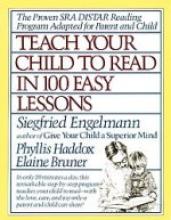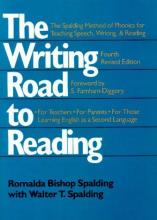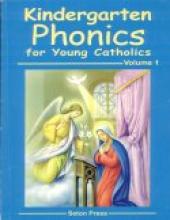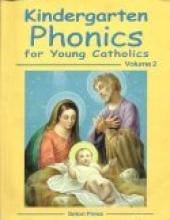Phonics
Right Track Reading Lessons
Sound Beginnings
The program includes everything you will need including a 500+ page Bible reader, audio tape, flash cards, notebook, parent manual, handwriting paper, worksheets, and a pencil and gripper. Most of the program is non-consumable and could be used with any other children you may have. The lady who developed this modeled it (with her improvements) off of the Spalding method (i.e. Writing Road to Reading). She is a Catholic homeschooling mom with a Montessori background.
Note: The author of this program has used a Protestant Bible because the only Catholic one available that was designed for phonetic readers had just as many (if not more) theological errors as the Protestant one. The introduction to this program provides information on which passages should be corrected.
Teach Your Child to Read In 100 Easy Lessons
The 100 EL is a direct instruction program. This means that the teacher's dialogue is scripted. The sessions are designed to take 20 minutes per day. We found them to take 15 to 30 minutes a day. If it takes any longer, I recommend to stop using the program for a few weeks to let things "jell" then go back to it. I did this periodically with both children and they did not forget any of the previous material when we went back to it.
If your child is a cuddler and loves to be read to while sitting in your lap this is an excellent program. I often thought of our schooling not as home school but as lap school. I have a nephew who was not a cuddler and did not like to sit still and be read to. His mother tried this program on him and it was a constant battle which they soon gave up.
The 100 EL uses only itself (just a book), you and the child. There are no additional workbooks, tapes or other falderal to cost you money and waste time. It is extremely easy to use. Just sit down with your child, open the book and begin reading. There is no lesson planning involved. The sounds of the letters are taught first and the names are taught only at the end. This is consistent with recommended phonics teaching. By lesson 9 the child begins to sound out written words.
An example, the sound of m has already been taught, the sound of e has been taught, I quote,"1. Touch the first ball for me. I'm going to sound out this word. then you'll say it fast. (Point to ball under m). 2.What's the first sound I'm going to say. (Touch for two seconds). (Student should say mmm (release) Point to ball under e) What's the next sound I'm going to say? (Touch for two seconds) (student should say eee). 3. Return to first ball. My turn to sound it out. (Touch under m and e as you say "mmmeee" (return to first ball) Say it fast. (Slide quickly to end of arrow.) me. 4. (Touch first ball) You're going to sound out this word, then say it fast. Sound it out. Get ready (Touch under m and e as child says mmmeee without pausing between sounds. Repeat until firm.) (Return to first ball) Say it fast (Slide to end of arrow.) me". As you can see it uses a stimulus-response method.
It progresses quickly from words to sentences to stories (all contained in the book). By the end the student is usually reading on a solid 2nd grade level. With my first daughter we did the first half in kindergarten, the second half in 1st grade concurrent with another program (The Hewitt easy readers). My second daughter did it all in kindergarten. She is an exceptionally eager reader however and now, at 6 is reading books such as "Charlotte's Web" (her current favorite).
I follow up the 100 EL with The Writing Road To Reading used along with Teaching Reading At Home which is a supplement to TWRTR. It organizes the material so it is easier to use. The 100 EL is a good background for TWRTR in my opinion. I got the idea from Berquist's Designing Your Own Classical Curriculum.
The Red Letter Alphabet book
Pages are made of heavy cardstock
The Writing Road To Reading
Just as this book is much more difficult to use thanTeach Your Child To Read In 100 Easy Lessons, it is also more difficult to review. A companion book by Wanda Sanseri, Teaching Reading At Home, organizes the information into a one page flow chart, then expands each item in the flow chart systematically so you feel comfortable with what to teach when. The Riggs Institute also has an extensive web site (www.riggsinst.org) devoted to this and a lot of supplementary materials for the Writing Road To Reading.
WRTR is based on putting the 45 sounds of English into 70 phonograms or ways of spelling the 45 sounds in writing. A simple diacritical marking system is taught. An example of this is the letter a. It is introduced as the sounds of a (short sound), a (long sound), a (ahh sound) (the terms short and long are not used).The first sound of a is the most common so it is not marked, the second sound of a is underlined to show that it is saying the second sound and the third sound of a has a little number 3 written over it. By the way, consonant blends in which each letter still retains it sound are not taught.
The beginning of the program is the hardest. You introduce 4 phonograms each day by showing a flash card of the letter while saying the sound(s) of it. The student says the sound. You show how to write the letter. They are grouped by similar shape so you start with a, c, d, g and o which are formed similarly. There are detailed instructions as to presenting this. Being a "fine-motor-skill-challenged" family this was the most difficult. After three weeks the student should know the first 54 sounds. They then begin a spelling notebook. The words are dictated by the teacher. The students say each phonogram sound or syllable in it, then write each one, then read it. Then they mark it appropriately. After 150 words are presented by this method they then begin reading. They claim that reading is never taught, that after explicit, intensive phonics instruction and the encoding of words by spelling in this manner children are just able to read. They spell their way into reading. My children already read when we started this program so I cannot vouch for that. There are also 29 spelling rules such as the 5 ways silent e's are used in English taught along the way.
Spalding did not want children to be reading twaddle (not her word but appropriate here) but the finest in children's literature. There is a long appendix in the back of recommended books grouped by grade level.
120 pages of the book are devoted to a spelling list which is to be used for grades 1 through 4. Each year a new spelling notebook is begun using a sewn composition notebook. All the phonograms and spelling rules are reviewed by writing them in each year's new notebook. 30 spelling words a week are recommended by Spalding and 20 a week by Sanseri. With my children I use 20 per week. I introduce 5 per day M-Th then have a test on Friday. They are reviewed and practiced by being used in sentences, playing hangman, etc.
Even though my children were already reading when we began the program I feel it was very valuable to give a thorough review of phonics and to apply phonics in the spelling lesson, not in the reading lesson. I plan to continue using it as a long term spelling program. I think the way spelling is taught in this program makes sense. My children's reading continues to improve and we have become comfortable with using it. By the way Spalding says the lessons take 3 hours a day, Sanseri says that in a home situation it takes about an hour per day. So far with both children at 2 different levels entailing 2 separate lessons it has never taken more than 1 hour per day for us. This program was recommended to me very highly by many people and I am glad I took their advice. The key phrase which sums up this complex program is "spell your way into reading."
Copyrights: 1957 revised, 1990.
Kindergarten Phonics for Young Catholics
Unit one has twenty five lessons. The first eleven are Listening skills (stories and poems), Visual Discrimination (broad similarities, detailed similarities and detailed differences), and Motor Skills (straight and curved lines, detailed dashed, detailed straight, and slanted lines and geometric shapes).
The next nine lessons are on auditory/visual discrimination. There are then three lessons on visual discrimination involving capital and lower case letters, letter identification and tracing. Then there is a another motor skills lesson and one on nursery Rhymes.
Unit Two is the beginning of learning phonics. The first few lessons are on the alphabet. Then on to letter recognition and identifying partner letters (capital and lower case). There are five lessons on motor and visuals skills.
After this the letter lessons begin. Each lesson begins with an intro to the letter. For example, the first letter taught is "S". So for "S" there are five lessons. The first is printing. The next: initial sound and printing. The third is letter discrimination. The fourth is initial sound and printing. The fifth and final lesson is final sound and printing.
Ther next letter taught is "T". After this there is a review of "S" and "T". After every two letters, there is a review of those two letters. After every four letters , there is a review of the four letters.
Unit Two covers the following letters: S,T,B,H,M,K,J,F,G,L, and D.
Kindergarten Phonics for Young Catholics
This volume begins with Unit three. It reviews the Alphabet sound list. Then it covers the following letters: N (including a N/M discrimination), W, C, R, P, Q, V, X, Y, Z. The lessons are the same setup as in Volume 1 (as explained above for the letter "S").
Unit four introduces the vowels. It begins by reviewing the consonants. Then it introduces Short "A". The lessons are as follows for Short "A". First is: recognizing the short sound of Aa. Then Short Vowel Aa. Then blending consonants with the short sound of Aa. Then Short Vowel Aa. Finally the short Aa sound in sentences. This is repeated for Short E, I, O and U. There are reviews after every two vowel sounds taught.
Unit 5 begins by reviewing consonants and short vowels. Then it teaches the two sounds of "C" and "G". Then it begins the long vowels.
It begins in with A. The lessons go as follows: First recognizing the long sound of Aa. Then discriminating between long and short A. Then blending consents with long A. Then again recognizing sound of the long and short A. Then it goes on to E, I, O, U long vowels. Reviews after *each* vowel.
The next section teaches consonant blends like SM, CR, PL, TR, GL, ST as initial sounds. Then final sound consonant blends like CK, NG, MP, SK, NK, and ST. Then the digraph TH is taught and the difference between T and TH.
The final section of volume two is about Y as a vowel. There are three lessons here involving Y with A, with E, and with I in one or two syllable words. The final two lessons are reading a little story about a puppy and answering questions for comprehension.






